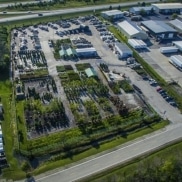Osmosis
The process in which molecules of a solvent (water) tend to pass through a semipermeable membrane (root hairs) from a less concentrated solution into a more concentrated one. This definition is geared towards osmosis in plant roots and the effect of watering plants. Roots have hair cells that absorb water through osmosis. The root tip is most active with the most active root hair development. The definition of osmosis simply explained for watering purposes is:
If the soil around roots is dry and the plant is dry, water added to the soil will flow into the roots by osmosis and then into the plant. If the soil is saturated with water and so are the roots, water will not be taken in and the plant will wilt due to lack of water.
The absorption of water by roots is a pressure driven process. High carbon dioxide and low oxygen decrease the absorption (waterlogged soil) lead to wilting. The effectiveness of roots is related to the extent of the root system.
Roots have four functions. Firstly, anchor the plant in the soil. Secondly, provide storage for carbohydrates and organic molecules. Thirdly site of synthesis for molecules/alkaloids, hormones. Finally, absorb and transport to the stem all water and minerals taken up by the plant.
Transpiration
Once water travels through a plant and reaches its leaves, it is released as vapor through the stomata, opening in the leaves. It also moves mineral ions around, keeps the plant sturdy with water turgor, makes sure the leaves have enough water for photosynthesis and keeps leaves cool in warm temperature.
Temperature effects
In hot strong sunlight the stomata are triggered to open and release water vapor. However, in the cold it is the opposite. In dry conditions plants transpire a lot. Humid wet conditions release less. The more transpiration the more water is pulled through the plants and roots absorb more water.










